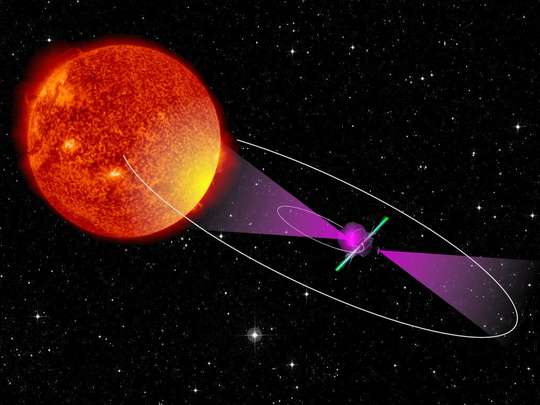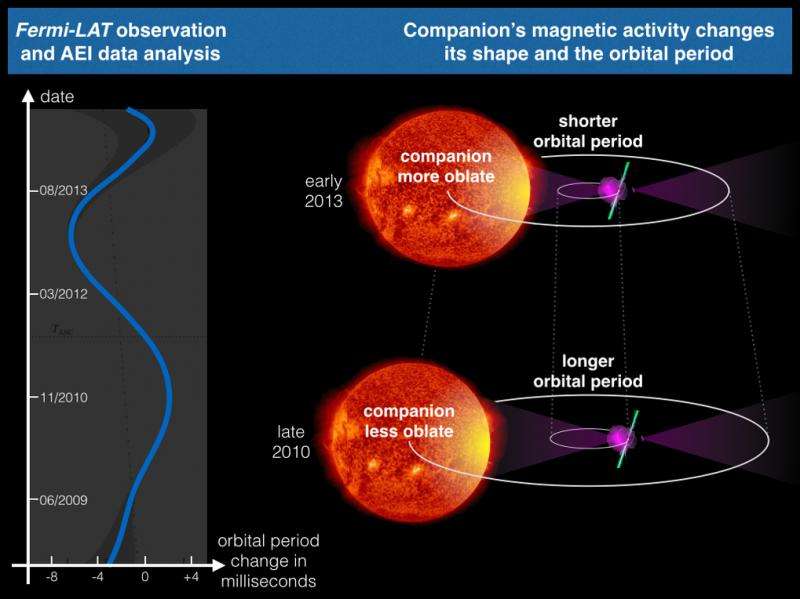Binary star system precisely timed with pulsar's gamma-rays

Pulsars are rapidly rotating compact remnants born in the explosions of massive stars. They can be observed through their lighthouse-like beams of radio waves and gamma-rays. Scientists at the Max Planck Institute for Gravitational Physics (Albert Einstein Institute, AEI) in Hannover, Germany, now have precisely measured the properties of a binary star system with a gamma-ray millisecond pulsar. Using new methods, the researchers analyzed archival data from the Fermi Gamma-ray Space Telescope more precisely than possible before. They discovered variations in the orbital period of the interacting binary system that can be explained by magnetic activity cycles of the companion star.
0FGL J2339.8–0530 – that is the catalog name of a celestial object which the Large Area Telescope (LAT) on board the Fermi Gamma-ray Space Telescope identified as a source of intense gamma radiation in 2009. Observations at other wavelengths in the following years suggested a possible explanation for its nature: a millisecond pulsar in a binary system with a companion star, each orbiting their common center of mass every 4.6 hours.
Only in 2014 could the pulsar now known as "PSR J2339–0533" be identified through its pulsed radio emission. The observations at radio wavelengths are hampered through the interaction of the pulsar with its stellar partner. The pulsar's radiation heats the companion and slowly vaporizes it. This causes clouds of gas to drift through the binary system, which absorb the radio emission and temporarily make the pulsar invisible. To completely characterize the system, regular observations over several years would be required.
Clear View with Gamma-rays
However, the gamma-rays emitted by PSR J2339–0533 penetrate the gas clouds and enable observations of the pulsar. "The photon arrival times registered by the Fermi-LAT depend on the physical properties of the stars and their orbits," says Holger Pletsch, leader of an independent research group at the AEI and lead author the paper now published in The Astrophysical Journal.
In turn, a precise measurement of the binary system's physical parameters can be inferred from an analysis of the photon arrival times. "After the first radio observations we immediately had a starting point. We knew we could use archival Fermi-LAT data from the past six years to study the system at high precision", says Pletsch.

Precise Measurement with New Methods
The use of new analysis algorithms was key. "Unlike previous methods that average the arrival times of many gamma-ray photons and lose time resolution as a consequence, our method is based on the arrival times of single photons", says Colin Clark, a PhD student in Pletsch's research group and co-author of the paper. "This allows us to measure the physical properties of the binary system to higher precision, especially on short time scales."
Pletsch's and Clark's results provide a very precise measurement of PSR J2339–0533, its companion, and their mutual orbits. This is the first such measurement of an interacting binary system through the gamma-ray emission of a millisecond pulsar. The scientists make full use of the Fermi-LAT time resolution, which is a few millionths of a second.
Magnetic Activity Varies the Orbital Period
The results show an unexpected variation of the orbital period. "We were surprised to discover that the orbital period slowly varies around the mean of 4.6 hours. The variations are a few thousands of a second, but compared to the measurement precision of millionths of a seconds, this is a lot", says Clark. "For the Earth's orbit this would mean that some years would be shorter or longer than others by a dozen seconds."
The most likely cause for these variations are tiny changes in the shape of the companion caused by its magnetic activity. Similar to our Sun the companion might be going through activity cycles. The changing magnetic field interacts with the plasma inside the star and deforms it. As the shape of the star varies its gravitational field also changes, which in turn affects the pulsar orbit. This can explain the observed orbital period variations.
"In the future simultaneous observations with optical telescopes can help us to prove the causal relationship between stellar activity and orbital period variations", says Pletsch. These observations can also improve our understanding of the binary system. "In a sense, the Fermi-LAT observations of the pulsar allow us to peek inside the companion. This might even be used to determine the type of magnetic dynamo in the star."
More information: Holger J. Pletsch and Colin J. Clark 2015 ApJ 807 18. DOI: 10.1088/0004-637X/807/1/18
Journal information: Astrophysical Journal
Provided by Max Planck Society




















